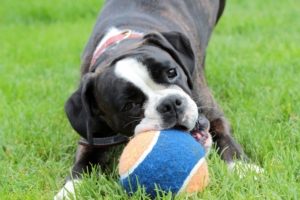Ask Crystal: Jumping Puppy
Welcome to “Ask Crystal,” where you can ask your pet behavior questions! You can submit your question for Crystal at the bottom of the page!

Dear Crystal,
When Lexie comes into a room she runs and jumps on whoever’s is sitting and licks them and is really excited. If we go to the dog park, she’s so happy and hyper and jumps on the other dog owners. She’s six months old.
Help, it’s so embarrassing.
Sincerely,
Embarrassed Owner
Dear Embarrassed,
I know having a puppy can certainly be challenging. Especially for those of us who have had adult dogs for a while. We forget all about the times in the beginning when they weren’t so calm and well behaved. I find it helpful to remind myself that a puppy is a baby. Babies don’t know the rules of society and don’t have self-control. You wouldn’t expect a toddler to know not to walk up and touch other people. To make it more complicated, dogs don’t have the same social norms as humans do. Puppies greet adult dogs by licking their mouths. It is a ritualized greeting that most likely started to simulate regurgitation feeding. Your puppy is just trying to greet in the way that is proper for her species. She jumps up because she otherwise can’t reach your mouth. It is our job to teach dogs the way that we would like them to greet. That is going to require management, training and consistency.
Management means that we prevent the dog from practicing the behavior. The more you allow a dog to perform a behavior the more difficult it will be to change the behavior in the future. Every time we perform a behavior the neuron path of that behavior becomes stronger. Imagine you are in a jungle with no paths before you. In order to move around you have to machete yourself a path. The more that you move through that path the easier it becomes to walk through it. If I ask you to choose another path, one that hasn’t been cleared, you aren’t going to want to take that path. All animals will choose the path of least resistance. In order to change behavior, we must make the choice we want them to take more attractive because they get what they want. The behavior that we don’t like needs to not pay at all, ever. In this way, the dog will begin to take the more difficult path until it becomes the well-worn path. That is where consistency is so important. There cannot be any one person who gives the dog attention for jumping up.
In your specific example, the people at the dog park are probably not going to help the situation. To make that situation work, you would need to go in first without the dog and ask them to ignore your dog for jumping and wait for her to do something more appropriate before acknowledging her. In my experience, you will get some people that will participate, some will say, “Oh, I don’t mind” and some will say, “Don’t bother me”. You must have total compliance, or it won’t work. If we reinforce the dog’s behavior only occasionally it actually makes it harder to get rid of the behavior when we try to stop then if we had been consistently reinforcing it. In dog training, we call that variable ratio intermittent reinforcement and it is the same principal that make slot machines so lucrative. The fact that we win randomly creates a euphoric experience which makes the behavior response stronger and hard to extinguish.
Unfortunately, my answer to jumping on people at the dog park, would be that until you get this behavior under control you shouldn’t be going to dog parks or anywhere she is allowed to jump on people who will not follow the training rules. I know that isn’t fun for anyone, but it is unfortunately a large part of the solution. You could potentially take her to a dog daycare where people understand training and will follow your instructions for her dog playtime. You might have a friend that you can set up playdates with. Playdates are a much better solution than dog parks. Most dogs prefer playing with dogs they know. It can be stressful to constantly have to interact with dogs they don’t know. Playdates allow you to instruct the other owner how to interact with your dog.
Behaviors that are attention seeking in nature can be extinguished by removing the reinforcement completely. Attention to a dog is being looked at, talked to or touch in any way. Pushing the dog off and yelling at it are still a form of attention so that’s why the behavior will continue with those responses. As soon as you can see the dog making the move to jump, try turning away or walking away. If you are sitting down, say nothing and stand up so that the dog must get off you. I almost always suggest that a puppy is wearing a leash around the house until they are trained. This way when she is being inappropriate and won’t calm down you can attach the leash to a door or a piece of furniture. This way she can be in the room where you can see her, but her movement is contained.
 It is important to give the dog an alternative behavior that she can do instead of jumping when she wants attention. What would be an acceptable behavior for her when she wants to greet someone? We usually start by rewarding four paws on the floor. That is something all dogs can do. Start out this training with people that live in the home first as that will be easier for the dog than new people who are very exciting. I usually have the dog on a tie down or leash and practice approaching. Any movement towards jumping up and the person should walk away. You must be watching for that moment when the feet are on the floor to reinforce the dog. I usually will say “yes” and feed a treat and walk away and repeat. As you practice this you can start to build up the duration that you wait before treating and later add pets in while the dog is calm and not jumping. If your dog knows that sitting is a valued behavior, you may be able to wait for the dog to sit and then feed a treat. Offered behaviors are so much better because the dog learns to offer appropriate behaviors rather than constantly being told what to do. You will then need to practice with her approaching people sitting down as dogs have trouble generalizing behavior. So even if she learned the behavior while people are standing, she is not going to understand that it also applies to people sitting down. Walk her calmly a couple feet away from the seated person. Instruct them not to acknowledge her unless she has all four on the floor or is sitting or lying down. When she is doing one of those behaviors, they can calmly feed her a treat. Walk her away and repeat many times. I would suggest that at the beginning stages they not talk to her in a high pitch tone or try to pet her. You can work up to talking and touching after much practice with the person calmly sitting. Once she has practiced a lot with people in the home, you can start to practice with willing participants like neighbors. Aside from the jumping up, if you don’t like a dog licking your face, I suggest turning your face up and away. In dog language, this is a signal to mean that the dog would like the social interaction to stop. You will see dogs do this a lot when they are feeling uncomfortable with something. Most dogs understand what that means and will stop licking.
It is important to give the dog an alternative behavior that she can do instead of jumping when she wants attention. What would be an acceptable behavior for her when she wants to greet someone? We usually start by rewarding four paws on the floor. That is something all dogs can do. Start out this training with people that live in the home first as that will be easier for the dog than new people who are very exciting. I usually have the dog on a tie down or leash and practice approaching. Any movement towards jumping up and the person should walk away. You must be watching for that moment when the feet are on the floor to reinforce the dog. I usually will say “yes” and feed a treat and walk away and repeat. As you practice this you can start to build up the duration that you wait before treating and later add pets in while the dog is calm and not jumping. If your dog knows that sitting is a valued behavior, you may be able to wait for the dog to sit and then feed a treat. Offered behaviors are so much better because the dog learns to offer appropriate behaviors rather than constantly being told what to do. You will then need to practice with her approaching people sitting down as dogs have trouble generalizing behavior. So even if she learned the behavior while people are standing, she is not going to understand that it also applies to people sitting down. Walk her calmly a couple feet away from the seated person. Instruct them not to acknowledge her unless she has all four on the floor or is sitting or lying down. When she is doing one of those behaviors, they can calmly feed her a treat. Walk her away and repeat many times. I would suggest that at the beginning stages they not talk to her in a high pitch tone or try to pet her. You can work up to talking and touching after much practice with the person calmly sitting. Once she has practiced a lot with people in the home, you can start to practice with willing participants like neighbors. Aside from the jumping up, if you don’t like a dog licking your face, I suggest turning your face up and away. In dog language, this is a signal to mean that the dog would like the social interaction to stop. You will see dogs do this a lot when they are feeling uncomfortable with something. Most dogs understand what that means and will stop licking.
 Be sure that she is also getting proper exercise so that she is as calm as a 6-month old puppy can be for her training sessions. She is getting right in the thick of adolescence so this is the time when dogs are testing what they can get away with. Avoid putting her in situations where she is incapable of behaving calmly. This is the time to buckle down on your training and to be sure to have rules in place of what behavior is reinforced and what is not. Everyone that interacts with her should be adhering to these rules all the time. I highly suggest joining a group training class. This is a common puppy issue that most classes will cover and practice teaching appropriate greetings. There will likely be other puppy owners there as well, so a group class often turns into an adolescent dog support group so that is an additional benefit. Good luck and happy training!
Be sure that she is also getting proper exercise so that she is as calm as a 6-month old puppy can be for her training sessions. She is getting right in the thick of adolescence so this is the time when dogs are testing what they can get away with. Avoid putting her in situations where she is incapable of behaving calmly. This is the time to buckle down on your training and to be sure to have rules in place of what behavior is reinforced and what is not. Everyone that interacts with her should be adhering to these rules all the time. I highly suggest joining a group training class. This is a common puppy issue that most classes will cover and practice teaching appropriate greetings. There will likely be other puppy owners there as well, so a group class often turns into an adolescent dog support group so that is an additional benefit. Good luck and happy training!
Until next time,
Crystal







